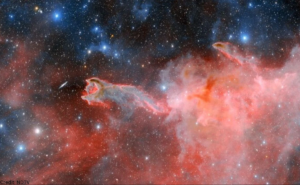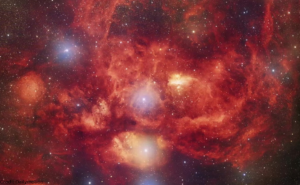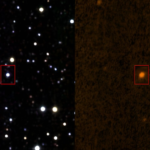Located more than 100 million light years away, “God’s Hand” seems to be extending toward the spiral galaxy ESO 257-19 (PGC 21338). An amazing set of pictures taken with a Dark Energy Camera (DECam) show what appears to be a phantom hand reaching out toward a far-off spiral galaxy.
Dark Energy Camera captures spectral “God’s Hand”
The heavenly formations, known as “God’s Hand,” are made of gas and dust clouds. An uncommon occurrence known as a cometary globule was photographed by the DECam, which was mounted on the Victor M. Blanco Telescope in Chile, providing insight into the depths of the known cosmos.

Are cometary globules a type of?
Distinctive from comets, cometary globules were first observed in 1976. Having a long, dimly luminous tail, these comet-like clouds of gas and dust in space are dense and packed.
Created by the strong radiation from neighboring stars, they usually include nascent stars in their centers. In the course of star formation and evolution inside galaxies, cometary globules are crucial.
What Does God’s Hand Mean?
New photos of “God’s Hand” feature CG 4, a cometary globule 1,300 light years away in the constellation ‘Puppis’ that is part of the Milky Way galaxy. The main dusty head of CG 4 is shaped like a twisted hand and is 1.5 light-years across. Its tail is 8 light-years long. A light year, or roughly 9.46 trillion kilometers, is the distance light travels in a year.

“God’s Hand” seems to be stretching out toward ESO 257-19 (PGC 21338), a spiral galaxy located more than 100 million light years away.
Despite being called “God’s Hand,” the celestial formation is not supernatural in any way.
The stunning image of CG 4 was captured by the sophisticated DECam (Dark Energy Camera) on the 7,200-foot-high Victor M. Blanco Telescope in Chile.
Read More Articles
The Northern Lights in US sky capture by real-time footage
Dutch Eurovision contestant, unclear about destiny
The 2024 Cadillac CT5—the Most Expensive American Sedan Available
By chance, cometary globules were discovered in 1976 by astronomers examining pictures taken with the UK Schmidt Telescope. Due to their extreme faintness and frequent stellar dust cover on their tails, these formations are difficult to identify.
Make a commentHowever, the outer rim and head of CG 4 contain ionized hydrogen, which gives out a slight red glow that the DECam’s unique filter can detect. This radiation exposes the cometary globule, but over time, it erodes its head. Still, enough material remains inside for new stars to form, just like our sun does.










